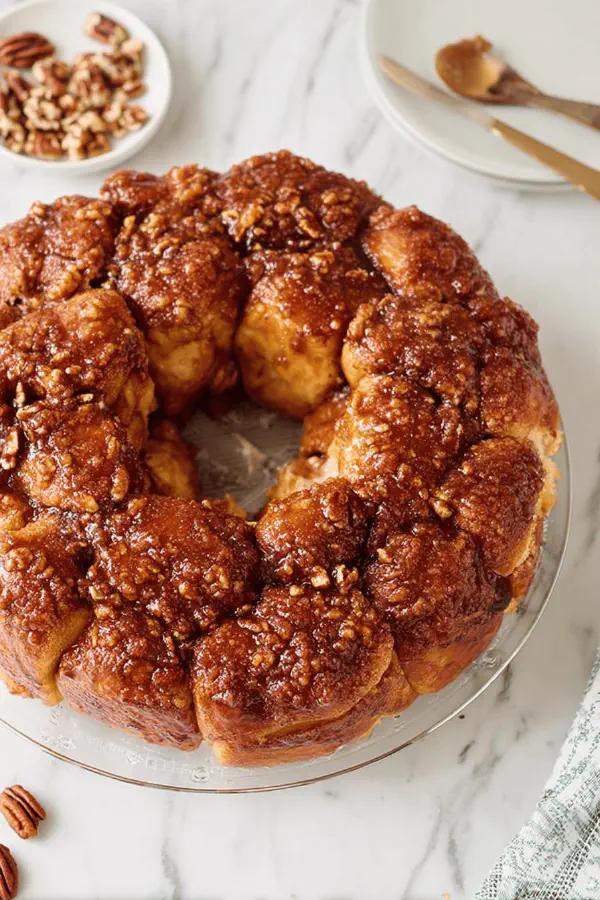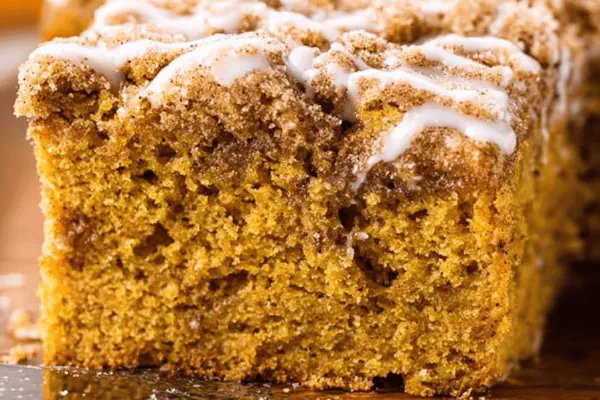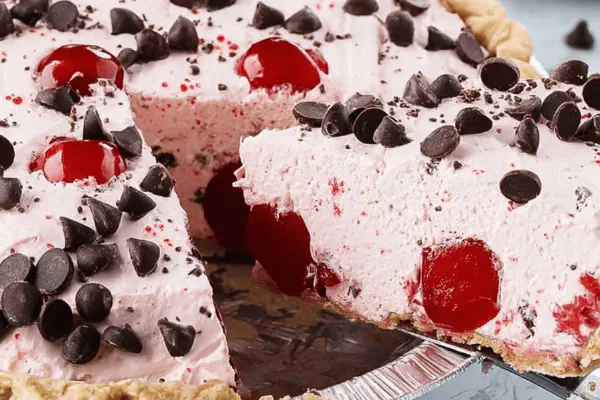Featured Recipe
Stuffed Cinnamon Monkey Bread

By Kate
"
Sticky pulls of cinnamon dough wrapped tightly around cream cheese cubes, baked layered with butter-sugar syrup and crunchy walnuts. A twist on classic monkey bread with tangy cream cheese pockets inside soft, golden buns. Brown sugar caramelizes on the sides, walnuts toast, aroma fills the kitchen. A Bundt pan holds the shape, easy to share. Watch for bubbling syrup edges and a deep golden crust. Serve warm, with a quick drizzle of warmed glaze. Sub two thirds of walnuts for pecans or sliced almonds. Use mascarpone or ricotta if cream cheese is tight. No Bundt pan? Use a deep round cake pan and monitor baking closely.
"
Prep:
20 min
Cook:
35 min
Total:
55 min
Serves:
8 servings
monkey bread
cinnamon
easy baking
Introduction
Sticky, buttery, sweet dough wrapped around gooey cheese chunks. Monkey bread with a twist; cream cheese fills the inside, melts during bake, pockets of tang and creaminess hidden in every pull-apart piece. Bake it in a Bundt pan where syrup caramelizes nuts and edges, making crunchy-sweet crusts. Brown sugar and granulated sugar simmered first with butter create a deep caramel flavor instead of a raw sprinkle dusting. Watch the bubbling edges for doneness cues—too soon, dough is doughy; too late, burnt sugars. Not just a dessert but a hands-on, share-around snack where timing and texture hold the key. Icing warmed for drizzle softens the final acidity. Chopped walnuts add crackle but swap pecans or almonds for variety or nut allergies. Inside is all about sealing that cheese—otherwise, it leaks, pools. Rolls slightly flattened allow cheese to nest safely then roll back to balls. Crowded pan means rising dough presses against each other making a connected pull-apart action. Think caramel babka crossed with monkey bread. Crisp edges, pillowy inside, gooey cheese core. Bubbles, crackles, that caramel smell overpowers. Keep an eye or risk burnt sugar bitterness. Oven set around 340 late enough caramelization, but slow enough to cook through. Practical hacks save browning but keep the chew. No Bundt pan? Use a mirror-round deep pan, check doneness visually with toothpick and aroma cues.
Ingredients
About the ingredients
Go for unsalted butter, lets you control salt level especially with salty cream cheese. Two types of sugar mimic old-school candy caramel textures: brown sugar for molasses notes, granulated for crisp caramel. Fresh walnuts bring soft bitterness; toast them first in dry pan medium heat until fragrant, or add raw for gentler texture. Cream cheese cubes—must be cold or firm from fridge to avoid squishy stuffing. Mascarpone or ricotta possible substitutes but texture changes; ricotta should be drained well. Cinnamon rolls from refrigerated dough save time but brands vary—look for thick dough with visible cinnamon swirl, not shriveled or dry. Spray pan with high-quality nonstick spray or butter and dust lightly with flour to prevent sticky caramel traps. If allergic to nuts, skip walnuts and add toasted coconut flakes for crunch instead. Brown sugar caramel can harden fast; stir constantly when melting to avoid boiling over or burning.
Method
Technique Tips
Start with preheating oven to 340—not your usual 350—because sugar caramelizes faster at higher temps, risk burnt edges. Bundt pan spray crucial, caramel glue gets vicious. Melt sugars and butter low and slow; bubbling syrup shows it’s thickening, sets a caramel base coating rolls as it cooks. Flatten just enough to wrap cheese, too thin tears, too thick means uneven bake. Seal edges fast by rolling dough ball between palms, traps cheese instead of leaking. Arrange rolls snugly—gaps let syrup flood, mess your bake, uneven rise. Walnut layers split dough stacks, add crunch inside too. Drizzle syrup incrementally, don’t dump all at once or bottom buns go soggy. Bake monitoring means watch for bubbling edges and a golden crust. Internal dough done when toothpick or skewer comes out with moist crumbs, no raw dough. Cool 7 minutes tops or caramel hardens and sticks; use thin spatula if tricky. A quick microwave 10-12 seconds softens icing for drizzle—don’t overheat or it separates. Serve warm, pulls apart with cheese strings inside. Store wrapped; reheat to revive gooeyness. Common issues: incomplete sealing of cheese causes leak, uneven rising from too tight or loose rolls, burnt edges from too hot oven or syrup pooling too thickly. Adjust times ±5 minutes per oven variability. Use tactile and visual cues, not just clock.
Chef's Notes
- 💡 Oven temp: 340 degrees for even caramelization. Higher heats burn sugars fast; watch edges closely—the bubbling signals you’re on track.
- 💡 Use cold cream cheese; prevents it from melting too quickly when baking. Cut cubes small enough to fit in dough without breaking it.
- 💡 Flatten rolls slightly. Not too thin or they tear. Just enough to encase cheese; pinch tight to avoid leaks. Sealing this well is key.
- 💡 Layer nuts—don't skip. Adds crunch inside too. Scatter before and during layering. Avoid overlapping too much. Eyeball it; adjust to your taste.
- 💡 Check doneness: toothpick test central. Should see moist crumbs, no raw dough. Bake too long and bottoms might burn; adjust based on your oven.
Kitchen Wisdom
Why is my monkey bread sticking?
Often from not spraying pan well. Use nonstick spray generously. Thin spatula helps loosen edges before flipping.
Can I make this ahead?
Prep is flexible. Assemble early; store covered in fridge. Bake later. Warm icing, drizzle before serving for fresh taste.
Nuts burnt during baking?
Nuts can burn faster; monitor closely. If edges brown too much, cover loosely. Half way switch positions—oven heat varies.
How to store leftovers?
Wrap tightly. Fridge up to 3 days. Reheat in microwave for gooey texture. Oven works too—restore crustiness fast.



